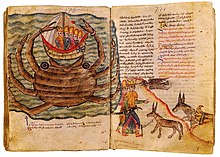|
Zaratan
 The saratan (from the Arabic سرطان, saraṭān, "crab"), sometimes spelled zaratan, is a giant sea creature from Arabic literature and folklore. In Arabic literatureThe Arabic polymath Al-Jahiz, writer of the ninth-century text Kitāb al-Hayawān (The Book of Animals), mentions three monsters that are supposed to live in the sea: the tanin (sea-dragon), the saratan (سرطان, or saraṭān, "crab") and the bala (whale). About the saratan, he said the following:
This monster is also mentioned in The Wonders of Creation, written by al-Qazwini, and in the first voyage of Sinbad the Sailor in The Book of One Thousand and One Nights.[2] In modern mediaThe saratan also appears in Jorge Luis Borges's work El Libro de Los Seres Imaginarios (The Book of Imaginary Beings), where its name is spelled "zaratan," a spelling which readers of Borges have adopted in reference to this creature. Borges describes saratans as having a long-life spans and incredible size, to the point where their shells can be mistaken easily for small islands.[3] Borges cites Al-Jahiz and the Kitāb al-Hayawān for this information, and notes Al-Jahiz's skepticism, which he contrasts with al-Qazwini's account.[4] Borges also appears to be responsible for the now-common representation of the saratan as a giant turtle, rather than a crab, though it is possible that this arose from confusion between this creature and similar creatures such as the aspidochelone. Under the name of zaratan, saratans also appear in some editions of the tabletop roleplaying game Dungeons & Dragons. Similarities with other creaturesThe saratan is one of several sea creatures in folklore to be mistaken for islands. Others include the aspidochelone, fastitocalon, lyngbakr, and Jasconius. See also
References
|
Portal di Ensiklopedia Dunia